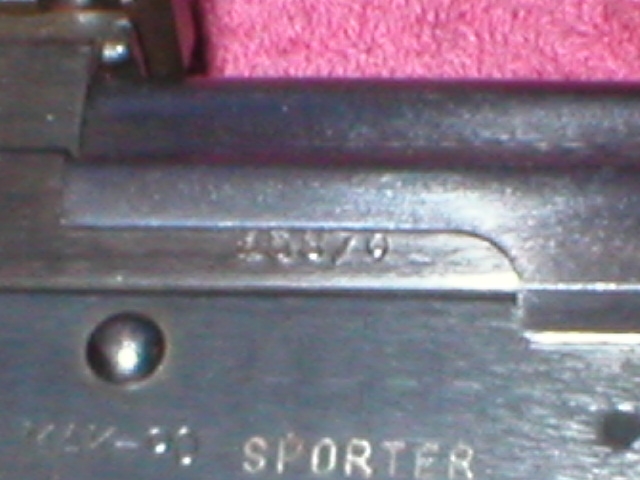Breaking News
Main Menu
Ak 47 Serial Numbers Romanian7890823
понедельник 31 декабря admin 13
Feb 12, 2008 - Homebuilt AK (and other firearms) - Serial Numbers and other issues Gunsmithing & How. Last edited by hoffmang; at 9:47 PM.
Rare £20 note AK47 serial numbers worth £4,000000. Do you have a collector’s note in your purse? Sell Online for FREE with bidallhours. Leave me a comment your url, i will advertise your website here for free. The Bank of England is auctioning bank notes that to the untrained eye look no different to those issued at ATMs.
Rare £20 note AK47 serial numbers AK47 81 58 18.They are £5, £10, £20 and £50 notes issued on November 2 last year and have nothing discernible to mark them out. However, because of their condition and serial number, they are worth a mint.Some are likely to fetch hundreds of pounds at auction. One £50 has a guide price of up to £400. While these notes are particularly special as they have not been in circulation and some have matching, low serial numbers, experts say not all valuable notes need bear these qualities.In fact an unassuming note you would hand over in a shop could be worth much more than its face value, just because of its serial number. Particular serial numbers can also increase the value of notes – the first four digits indicate this, and each note will also have a prefix,such as AK 47 some of which are more valuable than others. accurately determining the value of a note is much like any antique – you need experience, technique to know what you are looking at and to be able to spot forgeries. For those interested in note collecting, the Bank of England notes are set to be sold by auctioneers Spink in a charity auction. Look out for these AUCTIONS. Twenty pound note with AK 47 serial history. Totally uncanny one of its kind, rare collectible.
Bidding starts at £4000000. Unique, rare, historical descriptive numerical references to the Ak47 Kalashnikov Russian Assault Rifle. A chinese designed Kalashnikov and SKS based, second generation selective-fire, gas-operated 7.62 x 39mm.
Assault Rifle adopted by the chinese peoples liberation army PLA since the mid-1980s, Type 58 is an assault rifle made in North Korea derived from the soviet AK47 designed by Mikhail Kalashnikov. It uses a 7.62 x 39mm cartridge. It is the longest version of the Rifle at 890 mm, while the AK47 is 870 mm. The numbers 1 and 8 refers to the calibration of the Kalashnikov.
From (1) 100 metres through (8) 800 metres in 100 metre increments, the battle sight settings. The Rifle will be zeroed at 100 metres. The number 1 setting.
(800) metres with the number 8 setting and this is callibrated at 100 metre increments. Rare £20 note AK47 serial numbers is full of histrory and specifics regarding the AK47 which makes it unique and original. There is no other AK47 £20.00 note with these historical reference numbers in the world AK47 81 58 18. The note is a circulated £20.00 note. I have this on bidding, but am open to reasonable offers.
These £20.00 notes will shortly be coming out of circulation in 2018. It will be virtually imposible to find one with such historical reference, which will make it even more valuable and rare.
Rare serial number AK47 815818 Twenty pound notes were introduced by the for the first time in 1725. The earliest notes were handwritten, and were issued to individuals as needed.

These notes were written on one side only and bore the name of the payee, the date, and the signature of the issuing cashier. With the exception of the Restriction Period between 1797 and 1821 when the and the caused a bullion shortage, these notes could be exchanged in full, or in part, for an equivalent amount of gold when presented at the bank. Rukovodstvo po ekspluatacii traktora t 150. If redeemed in part, the banknote would be signed to indicate the amount that had been redeemed. From 1853 printed notes replaced handwritten notes, with the declaration “I promise to pay the bearer on demand the sum of twenty pounds” replacing the name of the payee. This declaration remains on Bank of England banknotes to this day. A printed signature of one of three cashiers appeared on the printed notes, though this was replaced by the signature of the Chief Cashier from 1870 onward.
The right to redeem banknotes for gold ceased in 1931 when Britain stopped using the. The twenty pound note ceased to be produced by the Bank of England in 1943, and it was not until 1970 with the introduction of the series D notes that the denomination reappeared. The predominantly purple series D notes were two-sided, with an image of appearing on one side, accompanied by an image of (all subsequent Bank of England notes also feature an image of the Queen) and an image of appearing on the other. This note also had a security feature in the form of a ‘windowed’ metal thread. The thread is woven into the paper so that it forms a dashed line, yet appears as a single line when held up to the light. Series D notes were phased out in favour of the newer series E notes beginning in 1991.
